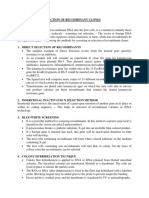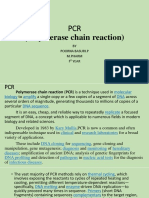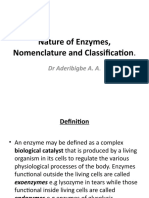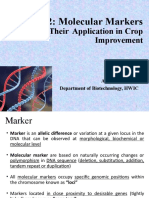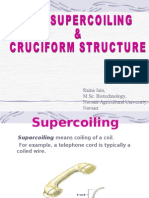0 ratings0% found this document useful (0 votes)
450 viewsMultiple Sequence Alignment 3
Multiple Sequence Alignment 3
Uploaded by
NandniA sequence alignment arranges DNA, RNA, or protein sequences to identify similar regions that may indicate functional or evolutionary relationships. Multiple sequence alignment aligns more than two sequences by inserting gaps to arrange homologous positions in a matrix. Progressive alignment methods build a multiple alignment starting with the most similar pairs and adding sequences according to a guide tree.
Copyright:
© All Rights Reserved
Available Formats
Download as PPTX, PDF, TXT or read online from Scribd
Multiple Sequence Alignment 3
Multiple Sequence Alignment 3
Uploaded by
Nandni0 ratings0% found this document useful (0 votes)
450 views22 pagesA sequence alignment arranges DNA, RNA, or protein sequences to identify similar regions that may indicate functional or evolutionary relationships. Multiple sequence alignment aligns more than two sequences by inserting gaps to arrange homologous positions in a matrix. Progressive alignment methods build a multiple alignment starting with the most similar pairs and adding sequences according to a guide tree.
Original Title
7. Multiple Sequence Alignment 3
Copyright
© © All Rights Reserved
Available Formats
PPTX, PDF, TXT or read online from Scribd
Share this document
Did you find this document useful?
Is this content inappropriate?
A sequence alignment arranges DNA, RNA, or protein sequences to identify similar regions that may indicate functional or evolutionary relationships. Multiple sequence alignment aligns more than two sequences by inserting gaps to arrange homologous positions in a matrix. Progressive alignment methods build a multiple alignment starting with the most similar pairs and adding sequences according to a guide tree.
Copyright:
© All Rights Reserved
Available Formats
Download as PPTX, PDF, TXT or read online from Scribd
Download as pptx, pdf, or txt
0 ratings0% found this document useful (0 votes)
450 views22 pagesMultiple Sequence Alignment 3
Multiple Sequence Alignment 3
Uploaded by
NandniA sequence alignment arranges DNA, RNA, or protein sequences to identify similar regions that may indicate functional or evolutionary relationships. Multiple sequence alignment aligns more than two sequences by inserting gaps to arrange homologous positions in a matrix. Progressive alignment methods build a multiple alignment starting with the most similar pairs and adding sequences according to a guide tree.
Copyright:
© All Rights Reserved
Available Formats
Download as PPTX, PDF, TXT or read online from Scribd
Download as pptx, pdf, or txt
You are on page 1of 22
SEQUENCE ALIGNMENT
A sequence alignment is a way of arranging the
sequences of DNA, RNA, or protein to identify
regions of similarity that may be a consequence
of functional, structural, or evolutionary
relationships between the sequences.
TYPES OF SEQUENCE ALIGNMENTS
Pair‐ wise alignment
• Dot matrix method
• Dynamic programming
• Word methods
Multiple sequence alignment
• Progressive methods
• Iterative methods
• Block based method
Multiple Alignment
• Proteins can be classified into families:
– Common structure.
– Common function.
– Common evolutionary origin.
• For a set of sequences belonging to some family
– Each pair has some differences
– But, there are some common motifs in almost all
sequences of the family
• A multiple alignment carries more information than
pairwise alignment
MULTIPLE SEQUENCE ALIGNMENT
A multiple sequence alignment is an alignment
of n > 2 sequences obtained by inserting gaps
(“‐”) into sequences such that the resulting
sequences have all length L and can be arranged
in a matrix of N rows and L columns where each
column represents a homologous position
Applications of multiple sequence alignment
• Identification of conserved sequence patterns
and motifs in the whole sequence family.
• An essential prerequisite to carrying out
– Phylogenetic analysis of sequence families
– Prediction of protein secondary and tertiary
structure.
• Designing degenerate polymerase chain
reaction (PCR) primers based on multiple
related sequences.
TYPES OF MSA
Progressive method
This approach repeatedly aligns two sequences,
two alignments, or a sequence with an alignment.
Iterative method
Works similarly to progressive methods but
repeatedly realigns the initial sequences as well as
adding new sequences to the growing MSA.
Block based method
The method identifies a block of ungapped
alignment shared by all the sequences.
PROGRESSIVE ALIGNMENT
• The most widely used approach
• Builds up a final MSA by combining pairwise alignments
beginning with the most similar pair and progressing to the
most distantly related
• Progressive alignment methods require two stages: ‐
• A first stage in which the relationships between the sequences
are represented as a tree, called a guide tree
• Second step in which the MSA is built by adding the
sequences sequentially to the growing MSA according to the
guide tree
• Clustal W is a progressive multiple alignment program.
WORKING OF CLUSTAL W
• First perform all possible pairwise alignments between
each pair of sequences.
• Calculate the ‘distance’ between each pair of
sequences based on these isolated pairwise
alignments.
• Generate a distance matrix.
• Generate a Neighbor‐Joining ‘guide tree’ from these
pairwise distances.
• This guide tree gives the order in which the progressive
alignment will be carried out.
Important features
Flexibility of using substitution matrix
It applies different scoring matrices when aligning
sequences, depending on degrees of similarity. The
choice of a matrix depends on the evolutionary
distances measured from the guide tree.
Adjustable gap penalties
A gap near a series of hydrophobic residues carries
more penalties than the one next to a series of
hydrophilic residues. In addition, gaps that are too
close to one another can be penalized more than gaps
occurring isolated.
PROS AND CONS OF PROGRESSIVE METHOD
OF ALIGNMENT
PROS
• Efficient enough to implement on a large scale for
many (100s to 1000s) sequences.
• Progressive alignment services are commonly
available on publicly accessible web servers, so
users need not locally install the applications of
interest.
• Most widely used method of multiple sequence
alignment because of speed and accuracy
CONS:
• Progressive alignments are not guaranteed to be
globally optimal.
• The primary problem is that when errors are made
at any stage in growing the MSA, these errors are
then propagated through to the final result.
• Performance is also particularly bad when all of
the sequences in the set are rather distantly
related
Iterative method
Works similarly to progressive methods but repeatedly
realigns the initial sequences as well as adding new sequences
to the growing MSA.
• To reduce the error in progress alignment, iterative methods
are introduced.
• Iterative methods are also heuristics.
• Basic idea:
– Generate an initial multiple alignment based on methods like
progress alignment.
– Iteratively improve the multiple alignment.
Block – Based Alignment
• For divergent sequences that share only
regional similarities.
• A local alignment based approach is used.
• The method identifies a block of ungapped
alignment shared by all the sequences.
• Block – based alignment programs is -
DIALIGN2
DIALIGN2
• The method breaks each of the sequences
down to smaller segments and performs all
possible pairwise alignments between the
segments.
• High – scoring segments, called blocks.
• It gives block-to-block comparison rather
than residue-to-residue comparison.
• The program is especially suitable for aligning
divergent sequences with only local
similarity.
Sum of Pairs
• The sum of pairwise distances between all pairs of
sequences for some scoring matrix
S (mi ) s (mik , mil )
k l
• Not only assumes that alignment of each column
is independent, but also each pair of sequences.
– Each sequence is scored as if descended from k-1
sequences instead of one common ancestor.
PSI- BLAST (Position Specific Iterated)
• BLAST provides a new automatic “profile like” search.
• Iterative procedure:
– Perform BLAST on database.
– Use Significant alignments to construct a “position specific” score
matrix.
– This matrix replaces the query sequence in the next round of database
searching.
• The program may be iterated until no new significant
alignments are found.
• Most commonly used search method today.
Creating a PSSM
• After aligning the sequences we see that there are
some conserved regions.
• We use the multiple alignment of Blast results to
create a Position Specific Scoring Matrix.
• This matrix represents information from a whole
family, it is more strict in highly conserved regions.
PSI-BLAST
PSI-BLAST is designed for more sensitive protein-protein similarity
searches.
Position-Specific Iterated (PSI)-BLAST is the most sensitive BLAST
program, making it useful for finding very distantly related proteins or
new members of a protein family. Use PSI-BLAST when your
standard protein-protein BLAST search either failed to find
significant hits, or returned hits with descriptions such as
"hypothetical protein" or "similar to...".
You might also like
- Bootstrapping PRESENTATION BY GROUP 4Document31 pagesBootstrapping PRESENTATION BY GROUP 4Aditi Mohan100% (4)
- Shuttle Vectors and Expression VectorsDocument2 pagesShuttle Vectors and Expression VectorsRaihanur Kiran100% (2)
- Lec 3 Isolation & Purification of EnzymesDocument15 pagesLec 3 Isolation & Purification of EnzymesAnnadurai PillaiNo ratings yet
- Blast (Basic Local Alignment Search Tool)Document28 pagesBlast (Basic Local Alignment Search Tool)yasasveNo ratings yet
- Shotgun SequencingDocument29 pagesShotgun SequencingKhyati JoshiNo ratings yet
- Bioinformatics. CH 3 Databases (Summarized Notes)Document5 pagesBioinformatics. CH 3 Databases (Summarized Notes)Trinity HarborNo ratings yet
- Gene PredictionDocument36 pagesGene PredictionAtul Kumar25% (4)
- Generation of Antibody DiversityDocument12 pagesGeneration of Antibody DiversityAltaf khan100% (1)
- Genetic RecombinationDocument19 pagesGenetic RecombinationVKM2013No ratings yet
- Recombination Models (Holliday Model)Document26 pagesRecombination Models (Holliday Model)ijazNo ratings yet
- Biopharming SlideDocument19 pagesBiopharming SlideSN ParvezNo ratings yet
- Bioinformatics in PAM AND BLOSUMDocument17 pagesBioinformatics in PAM AND BLOSUMgladson100% (15)
- Polycistronic and Monocistronic mRNAsDocument7 pagesPolycistronic and Monocistronic mRNAskailas ambadi100% (1)
- Genome Organization 1Document42 pagesGenome Organization 1nsjunnarkar100% (1)
- Cloning Vectors: Types & CharacteristicsDocument18 pagesCloning Vectors: Types & Characteristicsayush100% (2)
- Downstream ProcessingDocument20 pagesDownstream ProcessingDrishti MalhotraNo ratings yet
- Substitution MatrixDocument10 pagesSubstitution MatrixRashmi DhimanNo ratings yet
- KT106 GeNei™ Immunoglobulin G Isolation Teaching KitDocument9 pagesKT106 GeNei™ Immunoglobulin G Isolation Teaching KitHemant KawalkarNo ratings yet
- Supercoiling of DNADocument40 pagesSupercoiling of DNAstevensb055No ratings yet
- PAM Blosum: Assignment 1 Bioinformatics (DSE 1)Document9 pagesPAM Blosum: Assignment 1 Bioinformatics (DSE 1)Maithili Joshi100% (3)
- Lecture/Lab: BLAST: Materials Last Updated June 2007Document11 pagesLecture/Lab: BLAST: Materials Last Updated June 2007Keri Gobin SamarooNo ratings yet
- Hoogsteen Base Pair PDFDocument7 pagesHoogsteen Base Pair PDFNikitaNo ratings yet
- Cloning VectorsDocument72 pagesCloning VectorsNiveditha Chalukya100% (1)
- Selection of Recombinant ClonesDocument2 pagesSelection of Recombinant ClonesKV Deepika100% (2)
- Principles of Cell CultureDocument20 pagesPrinciples of Cell CultureMicah Marie Cao AngeliasNo ratings yet
- Downstream ProcessingDocument30 pagesDownstream ProcessingResa100% (2)
- CentrifugationDocument20 pagesCentrifugationMuhammad Asif ShaheenNo ratings yet
- Chapter 19Document42 pagesChapter 19Dr. Manish KumarNo ratings yet
- Animal Tissue CultureDocument23 pagesAnimal Tissue CultureHui Jun Hoe80% (5)
- Chapter 7 Protoplast CultureDocument76 pagesChapter 7 Protoplast Culturerajiv pathakNo ratings yet
- Animal Cell Culture EquipmentDocument59 pagesAnimal Cell Culture EquipmentLeonNo ratings yet
- Polymerase Chain Reaction (PCR)Document29 pagesPolymerase Chain Reaction (PCR)Hamza KhanNo ratings yet
- Somatic HybridizationDocument27 pagesSomatic HybridizationManojkumar AyyappanNo ratings yet
- Numericals On DNA TopologyDocument5 pagesNumericals On DNA TopologySadab KhanNo ratings yet
- Csir Net NotesDocument63 pagesCsir Net Notesssjusvinder75% (4)
- Preservation and Maintenence of Industrial MicroorganismsDocument7 pagesPreservation and Maintenence of Industrial Microorganismskaunain100% (6)
- Selection of Recombinant ClonesDocument2 pagesSelection of Recombinant ClonesDeepika KVNo ratings yet
- Bioinformatics AnswersDocument13 pagesBioinformatics AnswersPratibha Patil100% (1)
- Genomes in Prokaryotes and EukaryotesDocument46 pagesGenomes in Prokaryotes and EukaryoteskityamuwesiNo ratings yet
- Alpha Domain StructureDocument35 pagesAlpha Domain StructureRekha Govindan100% (1)
- DNA Organization in Eukaryotic Chromosomes: Chapter 12: Section 12.4Document22 pagesDNA Organization in Eukaryotic Chromosomes: Chapter 12: Section 12.4Jaisy Samuel100% (1)
- 111raj Protein EngineeringDocument28 pages111raj Protein EngineeringRajesh Patel100% (2)
- ARS - NET Previous Questions - Agricultural Biotechnology Biology Exams 4 UDocument5 pagesARS - NET Previous Questions - Agricultural Biotechnology Biology Exams 4 UvalmikisatishNo ratings yet
- Plant Biotechnology NotesDocument16 pagesPlant Biotechnology NotesAnanya Singh100% (1)
- Strain ImprovementDocument15 pagesStrain ImprovementAlanChevalNo ratings yet
- Polymerase Chain ReactionDocument22 pagesPolymerase Chain ReactionPoornaBasuri100% (1)
- DNA SequencingDocument36 pagesDNA SequencingMuhammad Attique100% (1)
- DNA As Genetic Material PDFDocument12 pagesDNA As Genetic Material PDFRudra Narayan Swain 222No ratings yet
- Nature of Enzymes, Nomenclature and ClassificationDocument13 pagesNature of Enzymes, Nomenclature and ClassificationAbraham Oluwatimilehin IsaacNo ratings yet
- Inheritance Biology EDUNCLEDocument54 pagesInheritance Biology EDUNCLEEvita Almeida100% (1)
- Chapter 12 Molecular MarkersDocument39 pagesChapter 12 Molecular Markersrajiv pathakNo ratings yet
- Chromosome Walking: and David S. Hogness in The Early 1980'sDocument4 pagesChromosome Walking: and David S. Hogness in The Early 1980'sprakash singhNo ratings yet
- Molecular MarkersDocument39 pagesMolecular MarkersANUPAM SINGLANo ratings yet
- Unit 7 Operon ConceptDocument18 pagesUnit 7 Operon ConceptSarah PavuNo ratings yet
- Serial Analysis of Gene Expression (SAGE)Document34 pagesSerial Analysis of Gene Expression (SAGE)Rohit PhalakNo ratings yet
- Pure Culture, Preservation and Maintance Practical.Document17 pagesPure Culture, Preservation and Maintance Practical.Saim Sabeeh50% (2)
- Dna SupercoilingDocument16 pagesDna SupercoilingrainabtNo ratings yet
- 2-Mammalian Cell CultureDocument40 pages2-Mammalian Cell CultureUzair AhmedNo ratings yet
- Sds PageDocument36 pagesSds PageDivya DharshiniNo ratings yet





































